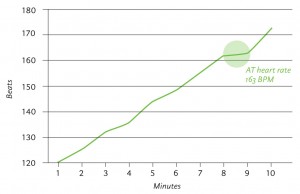Bike Trainer Fitness Testing
Use your indoor trainer to dial in your effort levels.
Who says you can’t improve your cycling over the winter? Just because you’re stuck indoors doesn’t mean you can’t get some high-quality training done. In fact, the work you do during the winter months can set you up for a stellar race season – if you do the right work, of course.
Threshold Testing
Ensuring you’re getting the most out of your training requires that you’re working at the correct intensity. There’s no point having a heart rate monitor and a power meter if you don’t know what the numbers they’re providing mean. There are many coaches and testing facilities who can help you come up with those numbers (look for a story on that in our January issue), but you can also do some testing at home that will help you maximize your training time.
When it comes to triathlon, one of the most defining numbers you need to be aware of is your anaerobic threshold (AT). That’s the point at which you stop getting enough oxygen to your system and start building up lactic acid. (Your lactic threshold (LT) is the point at which your body produces lactic acid faster than it can remove it.) As endurance athletes, the harder we can go until we reach both our AT and LT is of huge benefit when it comes to trying to improve.
One of the simplest ways to find out your AT is through a test designed by Italian exercise physiologist Francesco Conconi. You don’t have to have an expensive trainer to be able to do this test – virtually any trainer will do. You do need to have a cycle computer that will provide speed and cadence information, a heart rate monitor and a willing assistant to keep track of the test numbers.
Conconi Test
Warm up for 10 to 15 minutes.
Start pedaling at a comfortable cadence – for most triathletes that will be somewhere between 80 and 95 RPM.
Every minute raise the speed by 1 km/ hour.
Your assistant should keep track of your heart rate and speed every minute.
Once you can’t increase the speed any longer, you’re done.
Cool down for 10 to 15 minutes.
Once you’ve completed the test, graph the numbers. Here’s the graph of a test I recently did:

As you can see, this athlete’s HR increased in a linear fashion until he got to 163 BPM, at which point there was a break. That’s his AT heart rate.
You can repeat the Conconi test every six to eight weeks to gauge how your training is going and to see if you’re making any improvements in your AT numbers.
If you have a a computerized trainer like a CompuTrainer or a Tacx VR, you can automize the process and download the data to create your graph.
Fitness Testing
Assessing your AT is certainly an important part of your training, but sometimes there’s nothing like a regular test effort to see how you’re doing. An indoor trainer provides an easy way to do that – once a month you should do some sort of a time trial to gauge your fitness level. If you’re gearing up for an Olympic distance race, you might want to pick a distance of five or 10 km for your monthly test. If you have a longer race in mind you might want to go for a bit longer – between 10 and 20 km might be the key.
Do a good warm up before the set, then get rolling. You should aim for as even a pace as possible – this is also a great way to work on your pacing strategy, too. Keep track of your heart rate and the time it takes to finish the distance as a way of monitoring your fitness level. Once again, a computerized trainer can provide some added information for a test like this, including power data.
Kevin Mackinnon is both the editor of Triathlon Magazine Canada and a long-time triathlon coach.
